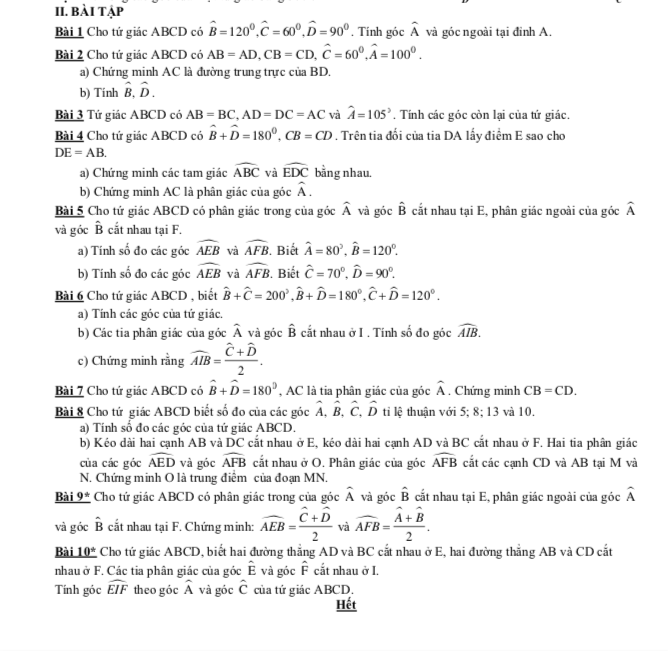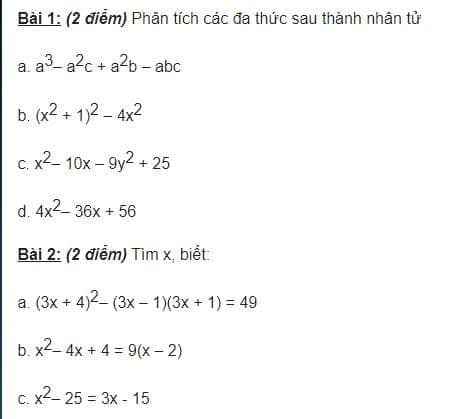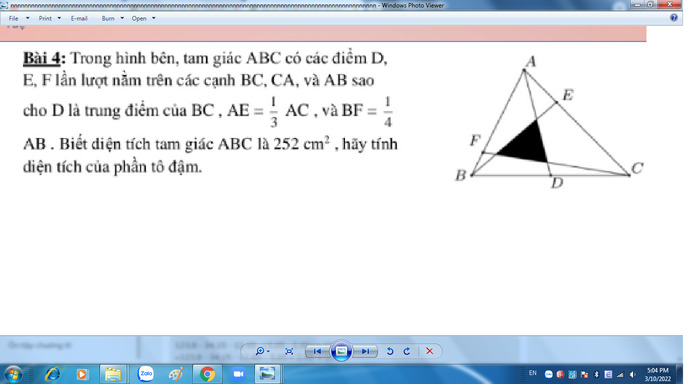
Hãy nhập câu hỏi của bạn vào đây, nếu là tài khoản VIP, bạn sẽ được ưu tiên trả lời.


Bài 1:
Vận tốc cano khi dòng nước lặng là: $25-2=23$ (km/h)
Bài 2:
Đổi 1 giờ 48 phút = 1,8 giờ
Độ dài quãng đường AB: $1,8\times 25=45$ (km)
Vận tốc ngược dòng là: $25-2,5-2,5=20$ (km/h)
Cano ngược dòng từ B về A hết:
$45:20=2,25$ giờ = 2 giờ 15 phút.

Bài 1:
a.
$a^3-a^2c+a^2b-abc=a^2(a-c)+ab(a-c)$
$=(a-c)(a^2+ab)=(a-c)a(a+b)=a(a-c)(a+b)$
b.
$(x^2+1)^2-4x^2=(x^2+1)^2-(2x)^2=(x^2+1-2x)(x^2+1+2x)$
$=(x-1)^2(x+1)^2$
c.
$x^2-10x-9y^2+25=(x^2-10x+25)-9y^2$
$=(x-5)^2-(3y)^2=(x-5-3y)(x-5+3y)$
d.
$4x^2-36x+56=4(x^2-9x+14)=4(x^2-2x-7x+14)$
$=4[x(x-2)-7(x-2)]=4(x-2)(x-7)$
Bài 2:
a. $(3x+4)^2-(3x-1)(3x+1)=49$
$\Leftrightarrow (3x+4)^2-[(3x)^2-1]=49$
$\Leftrightarrow (3x+4)^2-(3x)^2=48$
$\Leftrightarrow (3x+4-3x)(3x+4+3x)=48$
$\Leftrightarrow 4(6x+4)=48$
$\Leftrightarrow 6x+4=12$
$\Leftrightarrow 6x=8$
$\Leftrightarrow x=\frac{4}{3}$
b. $x^2-4x+4=9(x-2)$
$\Leftrightarrow (x-2)^2=9(x-2)$
$\Leftrightarrow (x-2)(x-2-9)=0$
$\Leftrightarrow (x-2)(x-11)=0$
$\Leftrightarrow x-2=0$ hoặc $x-11=0$
$\Leftrightarrow x=2$ hoặc $x=11$
c.
$x^2-25=3x-15$
$\Leftrightarrow (x-5)(x+5)=3(x-5)$
$\Leftrightarrow (x-5)(x+5-3)=0$
$\Leftrightarrow (x-5)(x+2)=0$
$\Leftrightarrow x-5=0$ hoặc $x+2=0$
$\Leftrightarrow x=5$ hoặc $x=-2$


Câu 4:
a: ĐKXĐ: \(x\notin\left\{0;-5\right\}\)
b: \(A=\dfrac{x^2+2x}{2\left(x+5\right)}+\dfrac{x-5}{x}+\dfrac{50-5x}{2x\left(x+5\right)}\)
\(=\dfrac{x^3+2x^2}{2x\left(x+5\right)}+\dfrac{2\left(x^2-25\right)}{2x\left(x+5\right)}+\dfrac{50-5x}{2x\left(x+5\right)}\)
\(=\dfrac{x^3+2x^2+2x^2-50+50-5x}{2x\left(x+5\right)}\)
\(=\dfrac{x^3+4x^2-5x}{2x\left(x+5\right)}=\dfrac{x\left(x^2+4x-5\right)}{2x\left(x+5\right)}\)
\(=\dfrac{x\left(x+5\right)\left(x-1\right)}{2x\left(x+5\right)}=\dfrac{x-1}{2}\)
c: Để A=-3 thì x-1=-6
hay x=-5(loại)

Điều kiện:
\(x-1\ne0\Rightarrow x\ne1\)
\(x^3+x\ne0\Leftrightarrow x\ne0\)

Ta có: \(\left(x-1\right)^2\ge0\) \(\Leftrightarrow x^2-2x+1\ge0\)\(\Leftrightarrow x^2+1\ge2x\).\(\left(1\right)\)
\(\left(y-2\right)^2\ge0\Leftrightarrow y^2-4y+4\ge0\Leftrightarrow x^2+4\ge4y\).\(\left(2\right)\)
\(\left(z^2-9\right)\ge0\Leftrightarrow z^2-6z+9\ge0\Leftrightarrow z^2+9\ge6z\).\(\left(3\right)\)
Từ \(\left(1\right),\left(2\right)\)và \(\left(3\right)\) nhân vế theo vế ta được:
\(\left(x^2+1\right).\left(y^2+4\right).\left(z^2+9\right)\ge48xyz\)
mà theo đề ta có:\(\left(x^2+1\right).\left(y^2+4\right).\left(z^2+9\right)=48xyz\)
nên \(\left\{{}\begin{matrix}x^2+1=2x\\y^2+4=4y\\z^2+9=6z\end{matrix}\right.\)
\(\Leftrightarrow\left\{{}\begin{matrix}x=1\\y=2\\z=3\end{matrix}\right.\)
Thay \(x=1;y=2;z=3\)vào biểu thức A ta được:
\(A=\dfrac{x^3+y^3+z^3}{\left(x+y+z\right)^2}=\dfrac{1+8+27}{\left(1+2+3\right)^2}=1\)
Vậy giá trị của biểu thức \(A=\dfrac{x^3+y^3+z^3}{\left(x+y+z\right)^2}\)là 1.

Hình bạn tự vẽ nhé!!!
Ta có: \(\widehat{ACB}=180^o-\widehat{ACD}=180^o-100^o=80^o\\ \)
Xét tam giác ADC ta có: \(\widehat{DAC}+\widehat{ACD}+\widehat{ADC}=180^o\)
\(\Leftrightarrow y^o+100^o+x^o=180^o\)
\(\Leftrightarrow x^o+y^o=180^o-100^o=80^o\left(1\right)\)
Xét tam giác ABC ta có:\(\widehat{BAC}+\widehat{ABD}+\widehat{ADB}=180^o\)
\(\Leftrightarrow2y^o+2x^o+x^o=180^o\)
\(\Leftrightarrow2y^o+3x^o=180^o\left(2\right)\)
Thế (1) vào (2) ta được: \(2.\left(80-x^o\right)+3x^o=180^o\)
\(\Leftrightarrow160^o-2x^o+3x^o=180^o\)
\(\Leftrightarrow160^o+x^o=180^o\)
\(\Leftrightarrow x^o=180^o-160^o=20^o\)
Khi đó giá trị của \(x=20\)
Chúc bạn học tốt![]()






 giúp mk nha mờn nhìu ạk
giúp mk nha mờn nhìu ạk








 Mọi Người giải giúp em ạ em cảm ơn ạ
Mọi Người giải giúp em ạ em cảm ơn ạ 

Bài 2:
a) Ta có: AB=AD(gt)
nên A nằm trên đường trung trực của BD(Tính chất đường trung trực của một đoạn thẳng)(1)
Ta có: CB=CD(gt)
nên C nằm trên đường trung trực của BD(Tính chất đường trung trực của một đoạn thẳng)(2)
Từ (1) và (2) suy ra AC là đường trung trực của BD(Đpcm)
b) Ta có: \(\widehat{BCD}=60^0\)
nên \(\widehat{CBD}=\widehat{CDB}=60^0\)
Ta có: \(\widehat{BAD}=100^0\)
nên \(\widehat{ABD}=\widehat{ADB}=\dfrac{180^0-100^0}{2}=\dfrac{80^0}{2}=40^0\)
\(\Leftrightarrow\widehat{ABC}=100^0;\widehat{ADC}=100^0\)